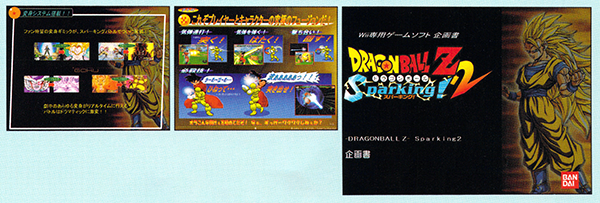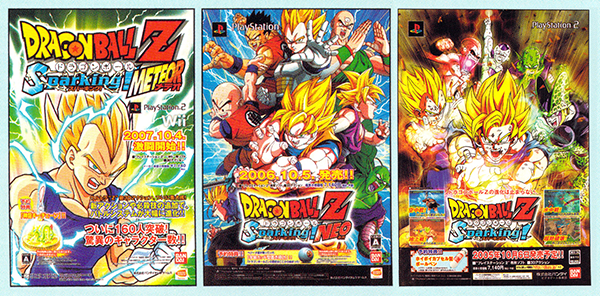30th Anniversary: Dragon Ball Chōshishū –Super History Book–
(21 January 2016)

Video Games Selection – Pick Up! 04
Taking on a new challenge, at this revolutionary time comes a monumental series that strove to continue breaking the mold!
Making 3D aerial battles a reality!
Dragon Ball Z: Sparking! series1
This time, with not only the characters but also the battle stage going 3D, there was finally a fighting game that made it possible to engage in three-dimensional battles. The large roster was also one of its features, so the fact that you could now play as extremely minor characters became a talking point. The “What If” mode, unlocked by clearing specific conditions in Story Mode, was also well received.
Series Data
Dragon Ball Z: Sparking! (“Dragon Ball Z: Budokai Tenkaichi”)
• Gaming system: PlayStation 2
◦ Release Date: October 2005
Dragon Ball Z: Sparking! NEO (“Dragon Ball Z: Budokai Tenkaichi 2”)
• Gaming system: PlayStation 2
◦ Release Date: October 2006
• Gaming system: Nintendo Wii
◦ Release Date: January 2007
Dragon Ball Z: Sparking! METEOR (“Dragon Ball Z: Budokai Tenkaichi 3”)
• Gaming systems: PlayStation 2, Nintendo Wii
◦ Release Date: October 2007
Memorial Interview: Ryō Mito
Dragon Ball Z: Sparking! series producer
“I tried really hard to surpass the players’ expectations in terms of the size of the character roster”
PROFILE: Producer at Bandai Namco Entertainment. He also worked on other games such as Dragon Ball Z: Burst Limit and the Dragon Ball: Raging Blast series.
The Proposal
We will now show you part of the written proposal for every game in the series, something that is not normally made public. Since it’s made before any actual development begins, things like the title and the systems might be a little different from what ends up in the final product, so it’s pretty interesting.
The proposal for Sparking!
At this point, the proposed title was Ultimate Evolution. Many terms and features ended up being different, but it seems like having a roster of more than 80 characters was already decided upon from the very start.

The proposal for Sparking! NEO
This is the proposal for the Wii version. “NEO” hadn’t yet been decided as the title, so at this point, the sequel just had a number attached. There was a strong emphasis on the unique way of controlling the game.

The proposal for Sparking! METEOR
The proposal for METEOR, which featured online battles.9 There were plans for around 150 characters, but ultimately, it ended up including more than 160.

Advertisements
These magazine advertisements placed special emphasis on the pre-order bonuses. There were a lot of amazing things, like a Hoi-Poi Capsule ballpoint pen, a space pod-shaped watch, and a Shenlong keychain.

2 The series of three numbered games released on the PlayStation 2 in Japan under the Dragon Ball Z series title were released internationally under the re-branded “Dragon Ball Z: Budokai” series title.
3 “Legend of the Fierce Battles of the Super Warriors”. A 1992 Nintendo Famicom Datach Dragon Ball Z card game was titled Gekitō Tenka’ichi Budōkai (“A Fierce Battle at the Tenka’ichi Budōkai”); a 1995 Nintendo Game Boy Dragon Ball Z game was titled Gokū Gekitōden (“Goku’s Fierce Fighting Legend”); a 2002 Nintendo Game Boy Color Dragon Ball Z game was titled Densetsu no Chō Senshi-tachi (“Legendary Super Warriors”). Any of these three games, not to mention several others with similar words in their titles, could have been in mind when selecting something different.
4 “Sparking!” is a notable exclamation from the Dragon Ball Z television series’ first opening theme, “CHA-LA HEAD-CHA-LA”, performed by Hironobu Kageyama.
5 As noted in the second footnote above, the Sparking! series titles were released with simple numbers appended to their international “Budokai Tenkaichi” titles.
6 Roughly 130 total forms/variations of characters.
7 Roughly 160 total forms/variations of characters.
8 Known as the “What If Saga” in the international version.
9 Specifically in the Nintendo Wii version, which it did ultimately ship with. The PlayStation 2 version ended up shipping with a “Disc Fusion System” that allowed the player to insert either the first or second game in the series to unlock specific fights.